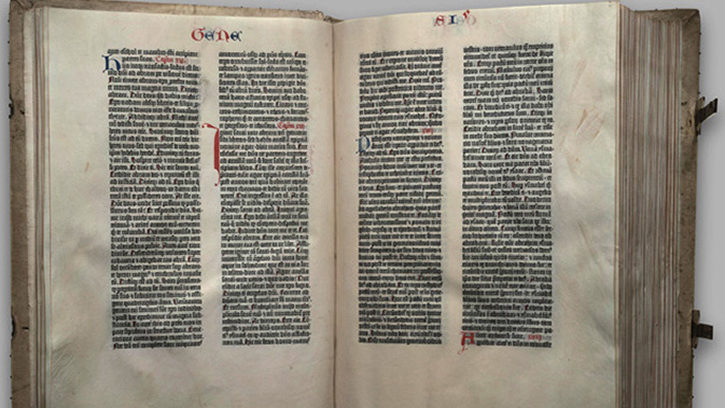At more than 500 pages, Bruce Gordon’s “The Bible: A Global History” (Basic Books, $35) is really a history of Christianity written from the perspective of sacred Scripture. The Bible is the book, the author says with some hyperbole, that has left no one — believing or unbelieving — untouched.
To trace its history, Gordon says, is “an attempt at the impossible.” His attempt looks at everything from the first texts of the Bible to its translations as well as the historical and personal interactions that it has produced.
Given the fact that Bible sales are on the rise, including among first-time buyers, this is a timely and important endeavor.
 No matter how familiar one is with the Bible, Gordon provides the reader with a fresh look. He chronicles the aesthetics of the illustrated manuscripts produced by the monks in the Middle Ages and the painstaking and often polemic work of translation throughout history. The details are a tsunami of data.
No matter how familiar one is with the Bible, Gordon provides the reader with a fresh look. He chronicles the aesthetics of the illustrated manuscripts produced by the monks in the Middle Ages and the painstaking and often polemic work of translation throughout history. The details are a tsunami of data.
For instance, I knew that the Gutenberg Bible was the Latin Vulgate translation, but I didn’t know that Gutenberg, whose printing of the Bible marked a turning point in world history, died broke.
I also learned some fascinating things about Martin Luther, the great promoter of sola scriptura (scripture alone).
His magistral translation of the Bible into German was not the first in that language. It succeeded some 70 other versions that were around by his time. His translation also was revised several times because he was working from Erasmus’ Greek text of the New Testament, which was imperfect.
Luther also at first changed the order of the books of the New Testament, relegating Hebrews, James, Jude, and Revelation to the end of the book, because he said they were “disputed.” The legend of the devil appearing to him while he translated the Bible in Wartburg tells us the Reformer tossed a bottle of ink at the Evil One, staining the wall of the castle cell.
The development of the Bible in English is a chapter that is both fascinating and amusing. Gordon says that Shakespeare was familiar with the Geneva Bible, an English translation produced by the Calvinist exiles in Switzerland that existed before the King James version.
While the King James Bible eventually became the Bible of choice, due to theological and political factors, its dissemination was not without comic errors.
Gordon writes about what is called the “Wicked Bible,” printed in England in 1631, which because of a typesetting error misprinted the Sixth Commandment to say, “Thou shalt commit adultery.” The edition was confiscated, but a few copies are still around, the latest surfacing in New Zealand just a few years ago. Other misprints produced nicknames for other editions, such as the Vinegar Bible, which misprinted the title of Christ’s Parable of the Vineyard with a more interesting formulation.
While Gordon writes from a Protestant perspective, he makes outstanding efforts to be fair. He defends the Christianity of the Middle Ages, invoking the ways that preachers and builders of cathedrals imbued their work with stories from Scripture.
While Gordon writes that he is not principally occupied with the editions of the Bible nor a history of its interpretations, he gives a great deal of information about both of these subjects.
From the Ethiopian Bibles to the latest translations used in Africa and Asia, he is knowledgeable about the extraordinary process of the dissemination of the Bible. He notes that while China exports a great quantity of Bibles (including a Spanish-language Bible) it severely restricts its people's access to the Holy Book.
In a chapter on Pentecostalism, which seems to be a defense of the movement in some respects, he says that, “Supernaturalism, long regarded by mainline Protestants and Catholics as having ended with the age of the apostles, very much fills the experiential world of believers.” I thought Catholics still believed in miracles.
He mentions that in some fundamentalist sects, the Bible is regarded as a talisman. Physical contact with a Bible can heal, and witches flee from the sight of the Holy Book.
“In Africa it is not uncommon to see Bibles at football matches, with supporters calling out particular Bible verses to aid their teams,” he writes. Fans hold open Bibles toward the playing field to pray for a win.
Gordon tells the story of an African woman with a doctorate who put a Bible in her child’s crib to ward off evil spirits. I suppose that there is a parallel here to Catholic sacramentals.
The book’s scholarship is impressive, reminding me of Arthur Piepkorn’s “Profiles in Belief” at times and at others of Sydney Ahlstrom’s “A Religious History of the American People.”
But even Homer might blink a bit, to twist Horace’s famous phrase. Perhaps it is an error of editing, but I was surprised by the line, “The book of Samuel recounts that Solomon sent Menelik back to Ethiopia accompanied by a son of the high priest Zadok (2 Samuel 15:24–29).”
Menelik, according to Ethiopian legend, was the lovechild of Solomon and the Queen of Sheba. The queen sent her son to see his father and Zadok’s son went to Ethiopia when Menelik (later Menelik I, ancestor of Haile Selassie) returned to his country, with the Ark of the Covenant. The story is told in the Kebra Nagast, an Ethiopian history from the fourteenth century, not in Second Samuel.
Gordon’s history is a hybrid sort of book: part story of Bible translations, editions and veneration, part world history, part comparative Christian theology, and part personal reflections on faith — but all well worth reading.

